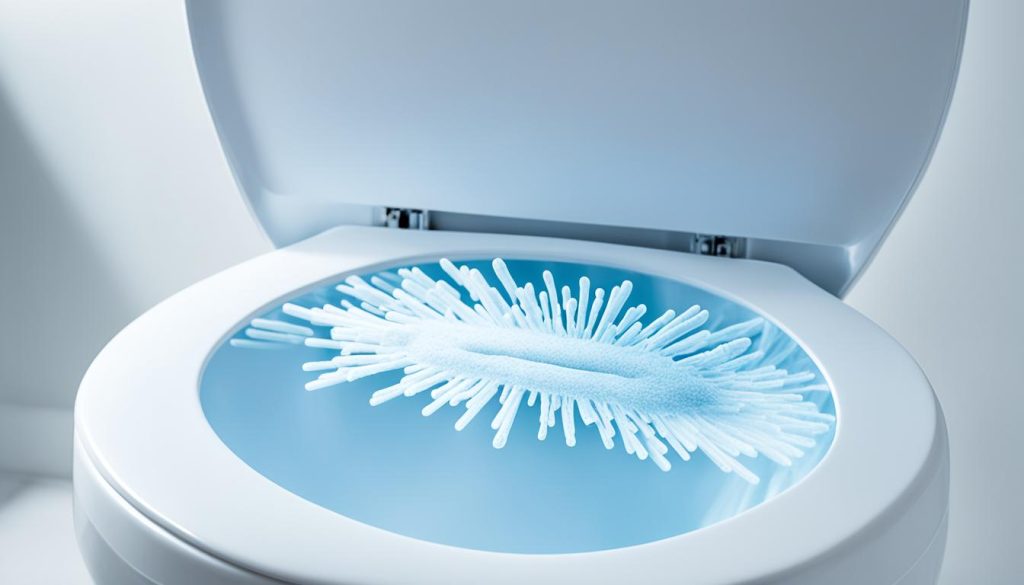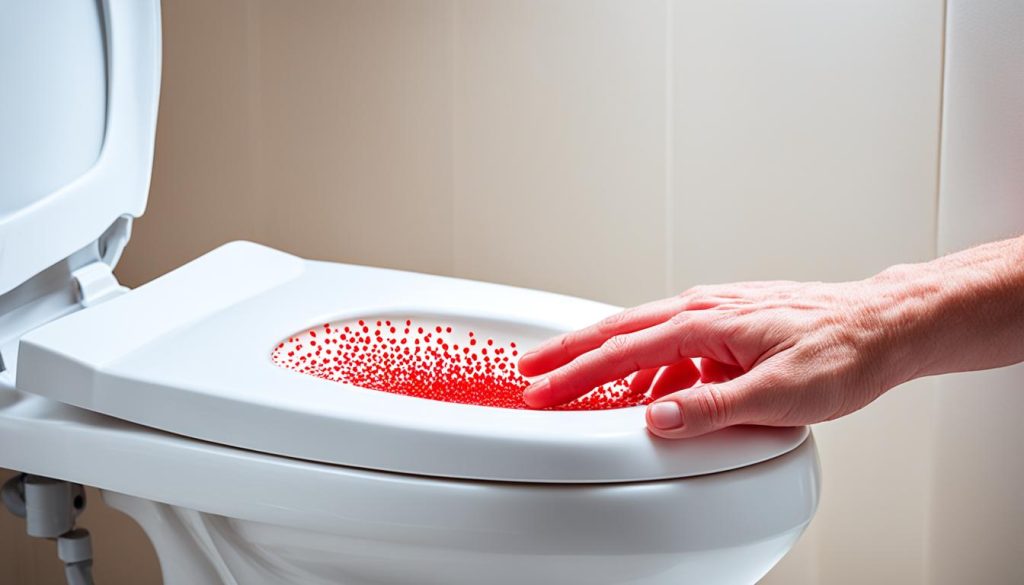While concerns about the germs on toilet seats are common, it’s important to understand the actual health risks associated with them. Experts suggest that various infections, such as the common cold, streptococcus and staphylococcus bacteria, E. coli, shigella bacteria, and even sexually transmitted organisms, can be present on toilet seats. However, the chances of contracting an infection from a toilet seat are very low. These germs can only survive for a short time on the surface of the seat and would require direct contact with vulnerable areas of the body, such as the urethral or genital tract, or an open wound for an infection to occur. Overall, if you have a healthy immune system and maintain good hygiene practices, the risk of getting an infection from a toilet seat is minimal.
What Kind of Infections Can You Get From a Toilet Seat?
When it comes to toilet seat hygiene, one common concern is the presence of bacteria that can potentially cause infections. Bacterial infections that can be found on a toilet seat include streptococcus, staphylococcus, E. coli, and shigella bacteria. These bacteria can be transferred from fecal matter or from people who have touched the seat with contaminated hands.
It’s important to note that while these bacteria may be present, they can only survive for a short period of time on the surface of the seat. The chances of contracting a bacterial infection from a toilet seat are low, especially if you practice good hygiene and take simple precautions.
Reducing the Risk of Bacterial Infections
Here are some tips to help minimize the risk of exposure to bacteria on a toilet seat:
- Use toilet paper or toilet seat covers to create a barrier between your skin and the seat.
- Avoid direct contact with the seat by hovering or squatting above it.
- Make sure to wash your hands thoroughly with soap and water after using the restroom.
- Consider carrying hand sanitizer for moments when soap and water are not readily available.
By following these simple hygiene practices, you can greatly reduce the risk of bacterial infections from a toilet seat. Remember, maintaining cleanliness and good personal hygiene should always be a priority.

| Type of Bacteria | Survival Time on Toilet Seat |
|---|---|
| Streptococcus | A few minutes to a few hours |
| Staphylococcus | A few minutes to a few hours |
| E. coli | A few minutes to a few hours |
| Shigella | A few minutes to a few hours |
Viral Infections from Toilet Seat
While concerns about the presence of germs on toilet seats are common, it’s important to understand the actual risks of viral infections. Viruses such as the common cold virus, hepatitis A virus, and various sexually transmitted organisms can potentially be present on a toilet seat. However, it’s crucial to note that viruses, like bacteria, can only survive for a short time on the surface of the seat.
The risk of contracting a viral infection from a toilet seat is low, especially if you practice good hygiene and wash your hands thoroughly after using the restroom. The chances of getting a viral infection from a toilet seat are minimal when compared to other modes of transmission.
By following simple toilet seat hygiene practices, you can further reduce the risk of viral infections. Using toilet paper or toilet seat covers to create a barrier between your skin and the seat can help minimize direct contact with any potential viruses. Additionally, washing your hands thoroughly with soap and water after using the restroom is crucial in preventing the spread of any potential pathogens.
Comparative Survival Duration of Viruses on Different Surfaces
| Surface | Common Cold Virus | Hepatitis A Virus | Sexually Transmitted Organisms |
|---|---|---|---|
| Toilet Seat | A few hours | A few hours | A few hours |
| Doorknob | Up to 24 hours | N/A | N/A |
| Countertop | Up to 24 hours | N/A | N/A |
| Cellphone | Up to 24 hours | N/A | N/A |
As seen in the table above, viruses, including the common cold virus, hepatitis A virus, and sexually transmitted organisms, can survive for a similar duration on various surfaces. The survival time of these viruses on a toilet seat is relatively short, reinforcing the minimal risk of viral infections.
By maintaining good personal hygiene and following responsible practices, you can reduce the chances of contracting viral infections and promote overall well-being.

Bottom line, while it is advisable to be cautious, the risk of viral infections from a toilet seat is minimal. A combination of practicing good hygiene, using protective measures like toilet paper or seat covers, and washing hands thoroughly after toilet use significantly reduces the chances of contracting viral infections.
Skin Infections from Toilet Seat
Skin infections from a toilet seat are rare, but they can occur, especially if you have an open cut or sore. In such cases, bacteria or viruses on the surface of the seat have the potential to enter your body through the open wound, increasing the risk of infection. While the chances of contracting a skin infection from a toilet seat are low, it is important to take preventive measures to minimize any potential risks.
One of the best ways to prevent skin infections from a toilet seat is to practice good toilet seat hygiene. Using toilet paper or toilet seat covers can create a barrier between your skin and the seat, reducing direct contact and the transfer of any pathogens. Additionally, avoiding direct contact between your skin and the seat by hovering or squatting can further minimize the risk.
After using the restroom, it is crucial to wash your hands thoroughly with soap and water. This simple practice can help prevent the spread of any potential bacteria or viruses that may have been transferred to your hands while touching the toilet seat.

By following these toilet seat hygiene practices, you can greatly reduce the risk of skin infections. Although the probability of contracting an infection from a toilet seat is minimal, it is always better to err on the side of caution and prioritize your hygiene.
Hygiene Tips for Public Toilets
When using public toilets, it is essential to prioritize hygiene and take necessary precautions to minimize the risk of infections. Following these hygiene tips can help ensure a safe and clean restroom experience.
1. Use a Barrier
To create a protective barrier between your skin and the toilet seat, consider using either toilet paper or toilet seat covers. These simple measures can significantly reduce direct contact with any potential contaminants.
2. Avoid Touching Your Face
It is crucial to refrain from touching your face, especially before you have had a chance to wash your hands thoroughly. This habit prevents the transfer of any germs or bacteria from your hands to your face, reducing the risk of infection.
3. Utilize Hand Sanitizer
If soap and water are not available, using hand sanitizer can be an effective alternative. Apply a generous amount of sanitizer to your hands and rub them together until dry. This helps eliminate any potentially harmful pathogens you may have come in contact with.
4. Flush with Caution
To minimize exposure to germs, consider flushing the toilet using either a tissue or your foot. By doing so, you avoid direct contact with the flush handle, which can harbor various pathogens.
5. Use Paper Towels
After washing your hands, use a paper towel to turn off the faucets and open the restroom door. This additional precaution minimizes the risk of recontamination from commonly touched surfaces.
6. Minimize Surface Contact
Whenever possible, avoid touching surfaces in the restroom. For instance, use your elbow or a paper towel to open doors, use non-contact payment methods in vending machines, and avoid direct contact with walls or other surfaces.
7. Wash Hands Thoroughly
After using the toilet, it is crucial to wash your hands thoroughly with soap and water for at least 20 seconds. This simple yet effective practice removes any potential pathogens, ensuring your hands are clean and free from germs.
| TIP | Why It’s Important |
|---|---|
| Use a Barrier | To minimize direct contact with potential contaminants on the toilet seat. |
| Avoid Touching Your Face | To prevent the transfer of germs from your hands to your face. |
| Utilize Hand Sanitizer | When soap and water are not available, hand sanitizer can effectively eliminate harmful pathogens. |
| Flush with Caution | To reduce exposure to germs on flush handles. |
| Use Paper Towels | To avoid recontamination from commonly touched surfaces in the restroom. |
| Minimize Surface Contact | To reduce the risk of encountering germs on various restroom surfaces. |
| Wash Hands Thoroughly | To ensure proper hand hygiene and remove any potential pathogens. |
By following these hygiene tips for public toilets, you can protect yourself from potential infections and maintain your well-being. Remember, practicing good toilet seat hygiene and proper handwashing are fundamental in minimizing the risk of illness.
The Importance of Handwashing
Proper handwashing is one of the most effective ways to prevent infections from any surface, including toilet seats. By washing your hands thoroughly with soap and water for at least 20 seconds after using the restroom, you can significantly reduce the risk of contracting infections. This simple yet crucial step helps remove any potential pathogens that may have been transferred to your hands during toilet seat contact.
Handwashing is particularly important when it comes to avoiding toilet seat diseases. By practicing proper hand hygiene, you can eliminate bacteria and viruses that may have come into contact with your hands in the restroom. Remember to lather your hands with soap, making sure to scrub all areas, including between your fingers and under your nails. Rinse your hands well under running water and dry them thoroughly using a clean towel or air dryer.
Toilet seat diseases can be easily prevented by incorporating handwashing into your daily routine. This simple act of hygiene not only protects you from potential infections but also helps prevent the spread of germs to others. It is especially important to wash your hands after visiting public restrooms, as these areas are frequented by many people and may have a higher concentration of germs.
While handwashing is vital in maintaining good hygiene, it is equally important to use proper handwashing techniques. By following the recommended guidelines and washing your hands thoroughly and frequently, you can minimize the risk of contracting infections from toilet seats or any other surface.

Why is Handwashing Important?
Handwashing is a critical component of overall hygiene as it helps prevent the spread of various illnesses and infections. The hands come into contact with numerous surfaces throughout the day, including toilet seats, which can harbor bacteria and viruses.
By washing your hands regularly, you can remove harmful microbes that may cause diseases. This is especially crucial after using the restroom, as the hands are likely to come into contact with potentially contaminated surfaces, such as toilet seats. Proper handwashing can help safeguard your health and reduce the risk of contracting illnesses.
The Reality of Toilet Seat Germs
While there is a common belief that toilet seats are teeming with bacteria and germs, the truth is that they are actually one of the cleaner surfaces in a household. Regular cleaning practices ensure that toilet seats have fewer germs compared to frequently touched items like cellphones, doorknobs, or kitchen cutting boards.
On average, toilet seats contain around 50 bacteria per square inch, which may seem like a significant number. However, it is essential to put this into perspective. For instance, kitchen sponges can harbor millions of bacteria per square inch, making them a far more concerning source of germs.
It is crucial to maintain good overall hygiene and cleanliness in your home, but there is no need to overly fear toilet seat germs. By implementing simple hygiene practices, you can further minimize any potential risks:
- Always wash your hands thoroughly with soap and water after using the restroom.
- Use toilet paper or disposable seat covers to create a barrier between your skin and the seat.
- Avoid direct contact between your skin and the seat, especially if you have any open cuts or sores.
- Consider using sanitizing wipes or disinfectant sprays to clean the seat before use, particularly if you are using a public restroom.
Comparison of Germ Levels (per square inch)
| Surface | Bacteria | Viruses |
|---|---|---|
| Toilet Seat | 50 | 0 |
| Cellphone | 25,127 | 1,479 |
| Doorknob | 8,643 | 276 |
| Kitchen Cutting Board | 200,000 | 1,000 |
As demonstrated by the table above, toilet seats have significantly lower bacterial levels than commonly touched items in our daily lives.
Therefore, while it is essential to practice good hygiene habits, there is no need to obsess over the germs on toilet seats. By maintaining cleanliness and being mindful of proper sanitation practices, you can minimize the likelihood of any potential infections.
Conclusion
The risk of contracting infections from a toilet seat is minimal if you have a healthy immune system and practice good hygiene. While there may be bacteria and viruses present on the surface, they can only survive for a short time and require direct contact with vulnerable areas of the body or open wounds for infection to occur.
Practicing good toilet seat hygiene, such as using toilet paper or seat covers, washing hands thoroughly, and avoiding touching surfaces, can further reduce the risk. By creating a barrier between your skin and the seat, you can minimize the chances of exposure to potential pathogens.
Remember to wash your hands with soap and water for at least 20 seconds after using the restroom. Proper handwashing is crucial in removing any potential germs that may have been transferred to your hands during your visit to the bathroom. By following these simple hygiene practices, you can comfortably use public toilets without being overly anxious about the germs on toilet seats.




